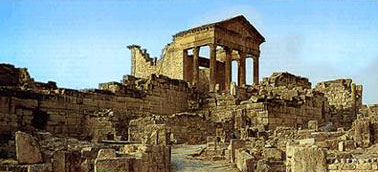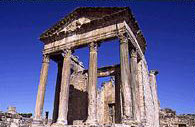NAME: Thugga (Punic).
LOCATION AND ACCESS:
110 km south-west of Tunis via the RN 5,
72km east of Kef, 8 km from Teboursouk.
DIALING CODE: 08.
ACCOMMODATION:
In Téboursouk (seeHotels Interactive Guide).
Bulla Regia and Dougga in Northern Tunisia evidence, in two very different ways, Roman presence in this agricultural region. At first sight Bulla Regia is disappointing, no great temples, arches or monuments mark the site, but don't drive on! Approaching the ruins, one is suddenly aware that part of the houses and baths are below your feet. In order to remain comfortable in the summer heat, houses were built with a winter apartment on ground floor and summer quarters underground with hollow air- pipes built into the walls. Light was provided by windows in the top floor and unlike sober Matmata, rich mosaics graced the floors. Unique testimony to the genius of the builders of the Coliseum and the aqueducts! Nearby is a small but interesting little museum.
Dougga is all that one dreams a Roman site should be. Grandiose temples and theaters, forum and markets stand in remarkable repair on a mountainside overlooking wheat fields and valley. Imposing Dougga spreads over 65 hectares, its position on the slopes forced Roman builders to renounce their standard city plan and adapt their monuments to the terrain.
The Capitol is certainly one of the most beautiful built by the Romans in Tunisia. Some 20 to 30,000 persons lived here and their shops, stores and baths, latrines, wash room and gymnasiums bring them to life. Stone streets bear the grooves of chariot wheels and in the silent, wind swept afternoon one can almost hear their clatter. Dougga was a prosperous city even before the coming of the Romans.
A Lybico - Punic tower from the 2nd century BC stands 21 meters high at the edge of the town, once ornamented by a stele bearing the names of its builders and Numidian princes were believed to have resided here. Dougga or Thugga is perhaps among the most touching of the 200 or more Roman sites in Tunisia as one cannot help the feeling it stands, like the Ksours, waiting for the peoples who will never return. A must for archeology buffs and a delight for all.



